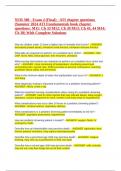NUR 380 - Exam 4 (Final) - ATI chapter questions
(Summer 2024 ATI Fundamentals book chapter
questions: M11: Ch 33 M12: Ch 39 M13: Ch 43, 44 M14:
Ch 38) With Complete Solutions
Why do children under 12 have a higher rate of mortality from burns? - ANSWER
decreased protein stores, immature renal function, immature immune function
What labs are important to perform on a pediatric burn victim? - ANSWER CBC,
CMP, BUN, ABG, blood glucose, liver enzymes, urinalysis
What nursing interventions are important to perform on a pediatric burn victim and
why? - ANSWER close monitoring of temperature, monitoring wound and
surrounding skin, wound care, ROM exercises to prevent contractures, teaching
guardians about safety and prevention
What is the minimum depth of water that asphyxiation can occur in? - ANSWER 1
inch deep
What diagnostic testing is important to perform on a pediatric drowning patient? -
ANSWER ABGs, chest x-ray
What are important nursing considerations when caring for a pediatric drowning
patient? - ANSWER look for other injuries that may indicate abuse; keep oxygen,
intubation, suction equipment in room; monitor core body temp for hypothermia
What complications may occur after 24 hours in a pediatric drowning patient? -
ANSWER cerebral edema, respiratory distress
What complications is a pediatric drowning patient immediately at risk for? -
ANSWER aspiration pneumonia, hypothermia
How are pediatric drowning patient s treated? - ANSWER oxygen, fluids, IV
emergency meds
Describe how an infant/toddler may perceive death. - ANSWER egocentric view,
mirrors parents' emotions, may regress developmentally
Describe how a preschool age child may perceive death. - ANSWER magical
thinking, may view as a punishment or their own fault
Describe how a school-age child may perceive death. - ANSWER with curiosity,
may act out, may fear things are out of their control
, Describe how an adolescent may perceive death. - ANSWER they may rely on
peers, experience increased stress in all parts of life, and have difficultly
communicating feelings to parents
How often should IVs be changed? - ANSWER every 3 days
How often should intraosseous lines (IOs) be removed? - ANSWER ASAP, are
typically only used in emergency settings/situations
Between 28-35 weeks gestation, how often should prenatal visits be? - ANSWER
once every 2 weeks
Between 35-36 weeks gestation to delivery, how often should prenatal visits be? -
ANSWER once every week
What medications may be given for postpartum hemorrhage and what are their
routes? - ANSWER oxytocin-IV
misoprostol-rectal
methergine-IM
hemabate-IM
TXA-IVPB
What blood loss qualifies as a postpartum hemorrhage? - ANSWER vaginal - 500
mL
cesarean - 1000 mL
What should be included in a postpartum assessment? - ANSWER breasts, uterus,
bladder, bowels, lochia, episiotomy/laceration/incision, Homan's sign/lower
extremities, emotional status/postpartum depression/psychosis
What about lochia should be assessed postpartum? - ANSWER color, amount,
clots, time to saturate pad
Describe the ideal FHR accelerations for a fetus under 32 weeks gestation. -
ANSWER 10 bpm above baseline for at least 10 seconds
Describe the ideal FHR accelerations for a fetus over 32 weeks gestation. -
ANSWER 15 bpm above baseline for at least 15 seconds
Describe early decelerations in relation to the contraction. - ANSWER mimics
pattern of contraction
Describe late decelerations in relation to the contraction. - ANSWER onset occurs at
peak of contraction, finishes after contraction ends
What do variable decelerations mean? - ANSWER cord compression
What do early decelerations mean? - ANSWER head compression: baby coming
down birth canal, close to delivery




